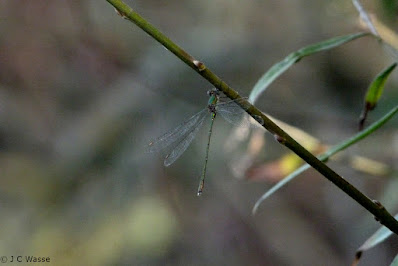Birded Rainham Marshes RSPB on the eastern edge of Greater London several times during October through to December.
The seasons changed quickly on the river whose muddy shore hosted up to 200 Black-tailed Godwits, only seen in such numbers as they flew to roost on the reserve's winter pools. A colour-ringed bird evaded confirmation of the exact combination, which would more than likely have revealed its Icelandic origins. In excess of 1,000 and probably around 2,000 Dunlin used this area of the Thames in the main to find high tide roosts and Redshanks and Lapwings fed along the exposed shore. A Common Sandpiper present in late October may have been the one continued to be seen into December. Ruff noted on one visit and the small group of wintering Avocets (40+) defied the tide. 3 Grey Plovers roosting with Lapwings one morning in early December were nice to see, in the past would have expected to pick out Golden Plovers amongst the Lapwings, but sadly Goldies are scarce to rare now in these parts. Curlew present, one in two in Aveley Bay, became 10+ on the reserve at high tide. Wigeon and Teal commonplace in Aveley Bay, over 500 Teal noted along a few hundred yards if shoreline in early November. The wildfowl shared this area with wintering (Scandinavian) Rock Pipits whereas Water Pipit could be heard 'wisting' over the reserve, the usual view being of a 'brown and white' Pipit disappearing towards the middle.
On the reserve the duck list grew with many Pintail showing well from the visitor centre. Grey Herons present, Little Egrets scarce and up to 3 Cattle Egrets seen in November. A presumed family party of Whooper Swans was a nice sight in late November, one adult eventually resting on the Target Pools, a rare winter visitor to this area. The reedbeds remained quite apart from the burst of Cetti's Warblers and one or two 'squealing' Water Rails.
Gulls represented by the expected five, supplemented by a couple of cracking adult winter Yellow-legged Gulls in late October, the same visit saw an adult winter Mediterranean Gull fly onto the river. A week earlier a late juv to 1st winter Common Tern drew attention.
Marsh Harriers showed well, usually 4 in the area, but at least 7 seen in mid December, be interesting to see how they compete or work as a team when hunting during the coming winter months. Buzzard and Kestrel regular and Sparrowhawk appeared out of nowhere. Peregrine noted, on one visit one screamed at another that entered the area and then followed it when it flew off to the north. Barn Owls were showy but I did not come close to seeing the world's most elusive Short-eared Owl present in the later months.
Other sightings included both Grey and Harbour Seals on the river and cracking views of Stoat on one visit, shown below. Dragonflies- Migrant Hawkers and presumed Ruddy Darters continued into November. Butterflies- seemed to be a movement of Red Admirals earlier in the period.
Elsewhere, in early December I twitched by bus, tube and train the Black-throated Diver and Great Northern Diver present on Staines Reservoir North Basin, London. Expecting dots on the horizon, but amazingly they swam close by. You could even hear them diving. The Black-throated Diver was underwater for about 45 seconds on most dives, similarly for the Great Northern Diver, which did just over a minute on one plunge. The following photos give an idea of the views.



















































